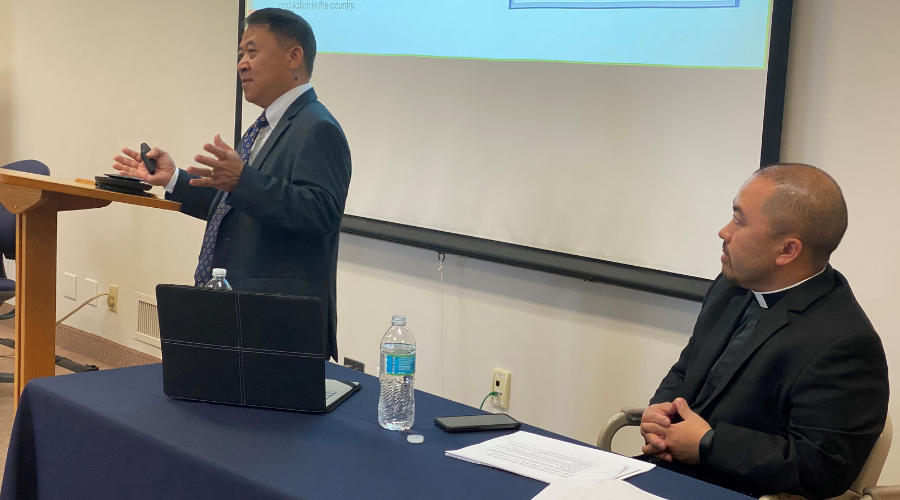
Kou Ly’s earliest childhood memories consist mostly of bombs and bomb shelters.
The permanent diaconate candidate at The Saint Paul Seminary Institute for Diaconate Formation was born during the Laotian Civil War, which lasted from 1959 to 1975 and was tied closely to the Vietnam War at the same time. A diaspora of displaced Hmong people like Ly came shortly after.
Ly’s family spent three years in a refugee camp before relocating to France, where he lived primarily at a Catholic convent so he could attend school. After college, Ly joined his many Hmong family members in the United States – first in Fresno, California, then the Twin Cities.
“What is the only way we can survive when we are suffering?” Ly remembers his father, uncles and cousins asking during those years in the Thai refugee camp. “Maybe we should become Christian? Because we can no longer practice what we know.
“So that’s why my dad and uncle decided to become Catholic; we all get baptized in the refugee camp for that reason. But I think once [Hmong people] get into the faith, they see the beauty of the faith.”
A race whose origins can be traced to the small mountain towns of China and Southeast Asia, the Hmong’s traditional, pagan religion is heavy on ritual. Ly and his family were attracted to the rituals of Christianity, the same way many Hmong converts have been throughout the decades since the war.
Hmong people are also deeply loyal to family – not just their immediate relatives, but their clan. There are 18 Hmong clans in all, and each has its own independent governance structure.
So when the Hmong nation began migrating to the U.S., they settled in tight-knit pockets — mainly in Minnesota, Wisconsin and California.
There are 66,000 Hmong people in the Land of 10,000 Lakes. St. Paul has the largest Hmong population of any U.S. city.
About 8,000 of Hmong people in Minnesota are Catholic.
“One of the things that I’ve appreciated just growing up is that our Catholic faith very much aligns with a lot of the values that a traditional Hmong family holds. … we look at the whole person, you know, there’s more than just a body and more than just a brain. There’s a spirit and a soul there as well.” — Fr. Peter Ly, first U.S.-born Hmong-American Catholic Priest
Many of them attend Presentation of the Blessed Virgin Mary Catholic Church in Maplewood, where Fr. Peter Ly is pastor. Born into a family of Hmong converts, Ly was born and raised Catholic before discerning his call to the priesthood.
The alum of both St. John Vianney College Seminary and The Saint Paul Seminary spends much of his time ministering to his native people.
“One of the things that I’ve appreciated just growing up is that our Catholic faith very much aligns with a lot of the values that a traditional Hmong family holds,” said Fr. Ly, the first U.S.-born Hmong-American Catholic priest. “First, family, again, and that communal life, which the church really stresses, too, and the spiritual life … we look at the whole person, you know, there’s more than just a body and more than just a brain. There’s a spirit and a soul there as well.”
When Ly was ordained in 2018, Hmong Catholics from all over the country attended the ceremony.
He and Kou Ly aren’t related – not directly, anyway. But they are part of the same clan. So is Olympic gymnast Suni Lee, the St. Paul native who won a gold medal in Tokyo earlier this year.
In their own ways, both Kou and Fr. Peter have helped evangelize among the local Hmong population. Because the group is so family-oriented, it starts by building trust and having conversations.
That can mean attending the long family gatherings and inter-clan discussions that are common among Hmong people. Fr. Ly is often at his parishioners’ homes late into the night, seeking to understand their specific spiritual needs and highlighting the common ground between their cultural traditions and the Catholic faith.
He and Kou also point out Christianity’s key place in Hmong history. It was Catholic missionaries in refugee camps who helped the Hmong formalize their current native language after they were forced to leave their homes.
Hmong people’s penchant for family and community is actually quite conducive to living the faith fruitfully, Kou says.
“I want you to become Catholic, but I don’t want you to lose your heritage,” said Kou, who joined Fr. Peter at The Saint Paul Seminary’s Ireland Library for one of several Cultural Empathy seminars put on by the seminary this year. “And I will do that for you. So don’t worry about becoming Catholic and losing everything.”
Kou, a graduate of the seminary’s Catechetical Institute, is about halfway through his diaconate training. Fr. Peter is three years into his priesthood and is already looked to as a leader among local Hmong Catholics.
Both see much potential to continuing to build the bridge between Hmong culture and Catholicism.
“We all have limits, right?” said Kou, a married father of five. “But we’ll take it one day at a time. … I still leave everything in God’s hands and say, ‘You know, Lord, if this is your will, I will do it.’”
